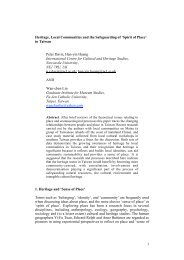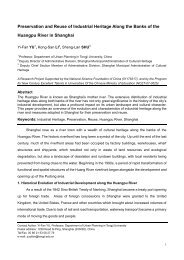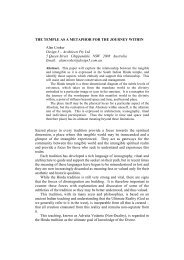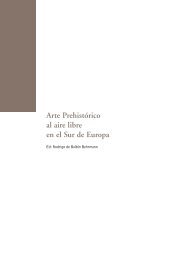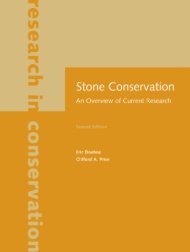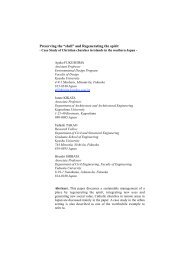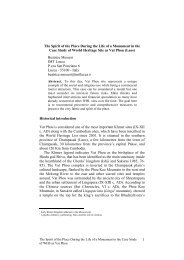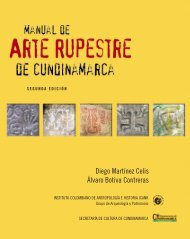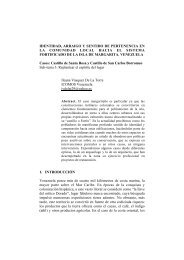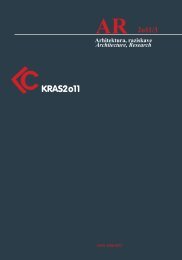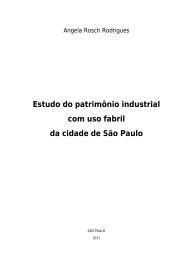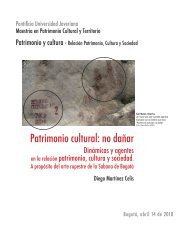Rendre compatible les techniques traditionnelles et les modernes ...
Rendre compatible les techniques traditionnelles et les modernes ...
Rendre compatible les techniques traditionnelles et les modernes ...
- No tags were found...
Create successful ePaper yourself
Turn your PDF publications into a flip-book with our unique Google optimized e-Paper software.
<strong>Rendre</strong> <strong>compatible</strong> <strong>les</strong> <strong>techniques</strong> traditionnel<strong>les</strong> <strong>et</strong> <strong>les</strong> <strong>modernes</strong>Compatibilizar técnicas tradiciona<strong>les</strong> y modernasCombining traditional and modern <strong>techniques</strong>Sample Ceramic Powder w/b Fc (MPa) Ft (MPa) P (%) S (mg/cm2s1/2)28d 90d 180d 28d 90d 180dB.2 n/a 0.8 1.0 1.6 1.3 0.5 0.6 0.5 34.8 26.41B.4 CB3 (0-150) 0.9 3.0 4.0 4.8 1.1 1.9 1.9 36.9 14.01B.7 CB11 (0-150) 0.9 0.5 1.0 2.0 0.2 0.5 0.9 37.1 22.33B.8 CB12 (0-150) 0.9 0.6 1.6 3.3 0.2 0.8 1.1 37.3 14.06B.9 CB2 (0-150) 0.9 0.6 1.4 3.5 0.3 0.7 1.4 36.5 19.47B.10 CB14 (0-150) 0.9 1.2 2.9 4.1 0.5 1.4 1.0 37.8 21.68B.11 CB31 (0-150) 1.0 0.9 2.7 3.1 0.4 1.2 0.5 37.5 25.88B.12 CB31 (0-150) 0.8 2.4 4.6 4.9 1.2 1.7 1.0 35.8 19.69B.14 CB31 (0-150) 0.9 2.9 3.0 3.6 0.7 0.6 0.9 37.3 19.74S.10 CB2 (0-75) 0.8 3.4 6.2 6.4 1.3 2.6 30.6 16.45S.15 CB2 (0-45) 0.8 5.4 7.5 1.7 2.7 29.1 8.55S.16 CB2 (75-150) 0.8 2.6 4.6 1.4 1.9 29.9 10.64S.20 CB2 (150-500) 0.8 1.2 1.7 0.5 0.6 34.8 21.10S.21 CB3 (0-75) 0.8 7.0 7.7 1.7 2.4 32.3 15.07S.25 CB3 (0-150) 0.8 5.0 1.4 31.0 13.05Table 2: Experimental results.presence of a dense carbonated rim on the surface of the sample whichprevented moisture from reaching the interior of the mortar [1].The experimental results confirmed the close relationship b<strong>et</strong>weencompressive strength and porosity. Fig. 4 shows that the compressivestrength of the experimental crushed brick-lime samp<strong>les</strong> increased withdecreasing porosity. The relationship b<strong>et</strong>ween these two fundamentalmortar properties may be described analytically as follows [22]:S = S 0(1=P) n (1)where S is the strength of mortar, S 0the theor<strong>et</strong>ical strength at zeroporosity, P the porosity and n a constant.The capillary absorption tests (Table 2) showed that the coefficient ofwater absorption (S) is dependent on the microstructural characteristicsof the mortar and, in particular, its porosity [23]. Mortars with lowerporosities and higher mechanical strengths (i.e. mortars with finerceramic powder), generally showed lower capillary water absorptionvalues, as would be expected from denser materials [13]. The results alsoshowed differences b<strong>et</strong>ween the aerial and the weak hydraulic mortars.The latter exhibited lower capillary water absorption coefficients.The evaluation of the physico-mechanical characteristics of theexperimental mortars should be carried out bearing in mind theircompatibility with old masonry [23]. Low mechanical resistance (~ 5.5MPa) and high porosity (35-40%) characterise one of the main buildingstones (i.e. the calcareous sandstone of the Nicosia-Athalassa formation)found on ancient monuments in Cyprus. The experimental mortarsexhibit lower strengths than the original stone and similar porosities.Therefore, one may assume that they are <strong>compatible</strong> with the units ofhistoric buildings and can be used for re-pointing and re-rendering.ConclusionsFollowing the physico-chemical characterisation of ancient mortarsfrom Cyprus, and adopting a “reverse” engineering” process, it becamepossible to prepare restoration mixtures having characteristics<strong>compatible</strong> with the traditional masonry structure. The repair mortarsconsisted of raw materials locally available.Examination of the physico-mechanical characteristics of theexperimental mortars indicated the main param<strong>et</strong>ers which d<strong>et</strong>ermin<strong>et</strong>heir strength, workability and durability. These are the binding systemand the water content.AcknowledgementsThe authors acknowledge financial support from the Cyprus ResearchPromotion Foundation. They also thank Dr. Ioannis Maniatis and Dr.Michele Machiarola for help with thermal and XRD analyses and Dr.Antonis Charalambides for his assistance with the chemical analyses.REFERENCES1. K. CALLEBAUT, J. ELSEN, K.V. BALEN, W. VIAENE (2001). Nin<strong>et</strong>eenth centuryhydraulic restoration mortars in the Saint Michael’s Church (Leuven,Belgium). Natural hydraulic lime or cement? Cement and Concr<strong>et</strong>eResearch 31, 397-403.2. M. Collepardi (1990). Degradation and restoration of masonry wallsof historic buildings. Materials and Structures 23, 81-102.3. D. Michoinová (1999). Lime based mortars for restoration of historicalmortars especially under wall paintings. In: P.J.M. Bartos, C.J.W.P.Groot, J.J. Hughes (Eds), Proceedings of the International RILEMWorkshop “Historic Mortars: Characteristics and Tests”, RILEM, Paisley,287-295.4. I. Holmström (1981). Mortars, cements and grouts for conservationand repair. Some urgent needs for research. In: Proceedings ofthe ICCROM Symposium “Mortars, cements and grouts used in theconservation of historic buildings”, Rome, 19-24.5. P. ROTA ROSSI-DORIA (1986). Mortars for restoration: basic requirementsand quality control. Matériaux <strong>et</strong> Constructions 19, 445-448.6. A. MOROPOULOU, P. MARAVELAKI-KALAITZAKI, M. BORBOUDAKIS, A. BAKOLAS, P.MICHAILIDIS, M. CHRONOPOULOS (1998). Historic mortars technologiesin Cr<strong>et</strong>e and guidelines for <strong>compatible</strong> restoration mortars. PACT:Journal of the European Study Group on Physical, Chemical, Biologicaland Mathematical Techniques applied to Archaeology 55, 55-72.7. Z. AL-SAAD, M.A.H. ABDEL-HALIM (2001). Laboratory investigation ofvarious types of mortars for the restoration of Qasr al-Bint monument,P<strong>et</strong>ra-Jordan. Engineering Structures 23, 926-933.554



